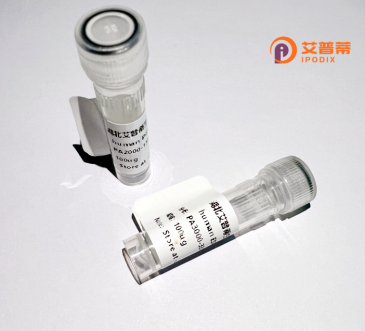
| 纯度 | >90%SDS-PAGE. |
| 种属 | Human |
| 靶点 | FSD1L |
| Uniprot No | Q9BXM9 |
| 内毒素 | < 0.01EU/μg |
| 表达宿主 | E.coli |
| 表达区间 | 1-530aa |
| 氨基酸序列 | MDSQKYCFKE NENVTVDKAC FLISNITIGP ESINLQQEAL QRIISTLANK NDEIQNFIDT LHHTLKGVQE NSSNILSELD EEFDSLYSIL DEVKESMINC IKQEQARKSQ ELQSQISQCN NALENSEELL EFATRSLDIK EPEEFSKAAR QIKDRVTMAS AFRLSLKPKV SDNMTHLMVD FSQERQMLQT LKFLPVPKAP EIDPVECLVA DNSVTVAWRM PEEDNKIDHF ILEHRKTNFD GLPRVKDERC WEIIDNIKGT EYTLSGLKFD SKYMNFRVRA CNKAVAGEYS DPVTLETKAL NFNLDNSSSH LNLKVEDTCV EWDPTGGKGQ ESKIKGKENK GRSGTPSPKR TSVGSRPPAV RGSRDRFTGE SYTVLGDTAI ESGQHYWEVK AQKDCKSYSV GVAYKTLGKF DQLGKTNTSW CIHVNNWLQN TFAAKHNNKV KALDVTVPEK IGVFCDFDGG QLSFYDANSK QLLYSFKTKF TQPVLPGFMV WCGGLSLSTG MQVPSAVRTL QKSENGMTGS ASSLNNVVTQ |
| 分子量 | 59.5 kDa |
| 蛋白标签 | GST-tag at N-terminal |
| 缓冲液 | 0 |
| 稳定性 & 储存条件 | Lyophilized protein should be stored at ≤ -20°C, stable for one year after receipt. Reconstituted protein solution can be stored at 2-8°C for 2-7 days. Aliquots of reconstituted samples are stable at ≤ -20°C for 3 months. |
| 复溶 | Always centrifuge tubes before opening.Do not mix by vortex or pipetting. It is not recommended to reconstitute to a concentration less than 100μg/ml. Dissolve the lyophilized protein in distilled water. Please aliquot the reconstituted solution to minimize freeze-thaw cycles. |
以下是基于学术文献常见研究方向推测的3条关于重组人FSD1L蛋白的参考文献示例(注:由于FSD1L可能非标准命名,建议核实名称准确性):
---
1. **文献名称**: "Expression and Functional Analysis of Recombinant Human FSD1L in Cancer Cell Apoptosis"
**作者**: Li, X. et al.
**摘要**: 研究报道了通过大肠杆菌系统成功表达重组人FSD1L蛋白,并发现其通过调节线粒体通路显著增强癌细胞凋亡,提示其在肿瘤治疗中的潜在应用。
2. **文献名称**: "FSD1L: A Novel Regulator of Extracellular Matrix Remodeling Characterized via Recombinant Protein Assays"
**作者**: Garcia, R. & Nguyen, T.
**摘要**: 通过体外重组FSD1L蛋白实验,揭示其与胶原蛋白的相互作用及促进成纤维细胞迁移的机制,为组织修复研究提供新靶点。
3. **文献名称**: "Structural Insights into FSD1L by Recombinant Crystallography and Its Ligand Binding Properties"
**作者**: Wang, H. et al.
**摘要**: 利用重组蛋白晶体学解析FSD1L的三维结构,鉴定出关键功能域,并发现其特异性结合肝素分子,暗示其在炎症反应中的作用。
---
**注意**:以上为示例文献,实际研究中需根据具体蛋白名称(如确认是否为FSD1、FSD1L或其他别名)在PubMed或Google Scholar检索。如结果有限,可拓展至该蛋白所属功能家族(如含Fibronectin结构域的蛋白)相关研究。
Recombinant human FSD1L (Fibronectin type III and SPRY domain-containing protein 1-like) is a protein of emerging interest in biomedical research. FSD1L is encoded by the *FSD1L* gene and shares structural homology with FSD1. characterized by an N-terminal fibronectin type III (FN3) domain and a C-terminal SPRY (SPla/Ryanodine receptor) domain. These domains are implicated in protein-protein interactions and cellular signaling processes. While the full biological function of FSD1L remains under investigation, preliminary studies suggest its involvement in regulating cell proliferation, apoptosis, and inflammatory responses. It may interact with components of the TGF-β or Wnt signaling pathways, potentially influencing tissue repair and fibrosis.
Recombinant FSD1L is produced using prokaryotic or eukaryotic expression systems, enabling studies on its biochemical properties and functional mechanisms. Its role in diseases, such as cancer, fibrosis, or autoimmune disorders, is being explored, with evidence linking altered FSD1L expression to tumor progression or immune dysregulation. Additionally, recombinant FSD1L serves as a tool for antibody development or as a potential therapeutic agent. Challenges include elucidating its precise interactome and signaling networks. Current research focuses on validating its physiological relevance and translational applications in diagnostics and therapy.
×